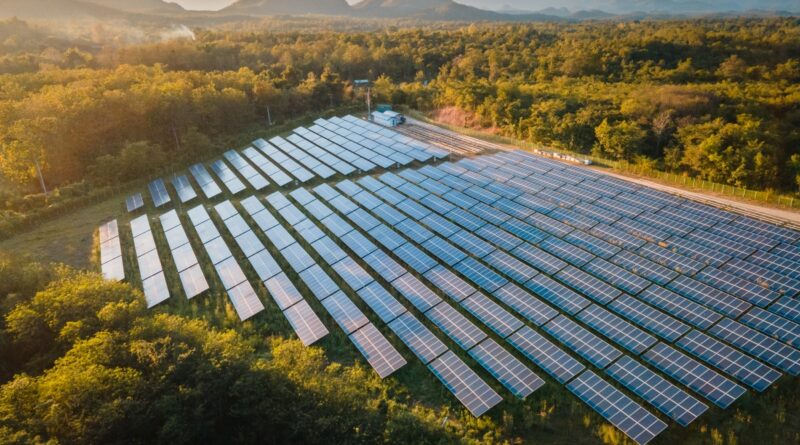Terraform Industries wants to solve climate change by making more hydrocarbons
Casey Handmer is not intimidated by very large quantities. Billions of acres. Thousands of gigawatts of solar power. A billion metric tons of carbon.
His startup, Terraform Industries, aims to operate at these ambitious scales. The company wants to turn hydrogen and atmospheric carbon into synthetic natural gas at scale. It’s more than a little mind-boggling, given that the startup is scarcely two years old, with fewer than 15 people on payroll and around $11 million in funding. But if the company succeeds in its goal — displacing a huge amount of carbon that’s released into the atmosphere — it’s the only scale worth operating in.
Terraform Industries has developed a system that captures carbon dioxide (CO2) from the air and creates hydrogen from water, all using cheap solar power. The system, called a Terraformer, then combines the hydrogen and CO2 into a chemical reactor to make natural gas. According to Handmer, the chemical reactor is hitting 94% methane purity already, which means that it is making synthetic natural gas fully compatible with existing distribution pipelines.
Combining hydrogen and carbon to make synthetic fuel has been done in various ways before. Historically, such processes used coal as the carbon input — hardly a carbon neutral substance. More recently, projects such as Store&Go in Europe achieved an atmospheric carbon to synthetic gas system, but Handmer said the group failed to hit positive economics. Other initiatives have successfully generated “green methane,” as it’s sometimes called, but they’ve been effectively kneecapped by the enormous energy demands of such processes and the high upfront capital costs of large-scale industrial projects.
Terraform Industries’ approach is different: Instead of physically massive systems, similar to today’s power plants, a single Terraformer is designed to fit into a shipping container. The company is betting that rapidly declining solar power costs, as well as market subsidies, will create favorable unit economics compared to existing fossil fuel production. Soon, Handmer estimates, it will be cheaper to synthesize natural gas from solar power rather than pull it from the ground.
The company’s goal is better thought of as an “Earthshot,” rather than moonshot. “Terraform,” a word most commonly used in science fiction novels, describes a process of greening an alien planet — to make it suitable for life. Such is one way of understanding Terraform Industries’ mission: to transform the Earth back into itself.
Handmer, who has a PhD from California Institute of Technology, said he started getting interested in synthetic fuels while he was still working at NASA’s Jet Propulsion Laboratory. At some point, he says he realized that natural gas “is probably the single best chance we [have] for doing something about climate change in my lifetime.”
“I may as well get on with making it happen.”
The Terraformer
The Terraformer is a simple machine. It’s composed of three subsystems: one that scrubs CO2 out of the air using direct air capture; an electrolyzer that creates cheap hydrogen from water; and a chemical reactor, sometimes called a methanation reactor, to make natural gas. All components have been designed in-house, and all three run on electricity generated from solar power. The result is a natural gas product that’s completely compatible with systems that use natural gas, like a gas stove, or that can be used as a raw material to make plastic, chemicals, fertilizer, paint or fuel.
“It’s completely substitutable,” Handmer explained. “It doesn’t require any chances, modifications, new pipelines, new infrastructure.”
It’s not the system that’s complex. In this case, it’s the business plan. In order to displace a meaningful amount of CO2 from the atmosphere and produce enough natural gas to start substantially replacing fossil fuels pulled from the ground, the company will need many, many, many Terraformers.
How many? According to a recent white paper, the company estimates it will need to build 8,000 factories in order to scale production of the Terraformer machines to more than 1 million units per month by the next decade. But it doesn’t end there. “Our civilization will need between 300 and 400 million machines, manufactured at a rate of about 60 million per year, which is comparable in terms of numbers, mass, and capital flows (but not complexity, fortunately!) to the global automotive industry,” the white paper says.
The process is also enormously energy intensive — “The energy demands are astronomical,” the company writes in a blog post — so just building the Terraformers is not enough. There will also need to be an incredible build-out of solar energy around the world. According to current estimates, Terraform thinks humanity will need to up the annual production of solar panels by something like 1000x. The white paper suggests that if production continues to increase at its current rate — doubling around every 33 months — we’ll hit that rate between 20-30 years. That much solar will require around 2 billion acres of land.
“Eighty-ninety percent of electricity generated on Earth will go into synthetic fuels,” Handmer said. “That’s pretty crazy. At the moment, it sounds crazy, but it is possible.”
Terraform Industries doesn’t plan on selling the natural gas, but the Terraformers. The majority of the company’s customers, Handmer expects, will be solar developers, who he said can commercialize the end product to natural gas purchasers. The gas could be put directly into a pipeline or onto a truck. In part, Handmer is confident that there will be enough solar capacity because of the revenue-generating potential of the Terraformer. Far from there not being enough solar capacity, he estimates that Terraformers will increase demand for solar by roughly a factor of 10. Eventually, the company wants to generate enough demand to mass produce Terraformers — enough to build 50-100 gigatons of carbon capture capacity all over the world. The idea, in incentivizing solar capacity, is to effectively flip the current system on its head: Instead of burning hydrocarbons to make electricity, it uses electricity to make hydrocarbons.
It’s slightly counterintuitive to combat climate change by producing hydrocarbons — and positively anathema to some climate activists to suggest humanity continue to pursue hydrocarbons at all — but Handmer insists that CO2 does not have “a moral valence.”
“There’s nothing inherently wrong with CO2,” he said. “Countries that emit a lot of CO2, generally speaking, have good quality of life, low poverty, and good economic development. The problem is that the CO2 comes from carbon which was underground and is now in the atmosphere, and it’s quite a slow process for life to take that carbon back out of the atmosphere and put it back underground. That imbalance is causing climate change.”
The company’s “success condition” is reducing net fossil carbon flows by 10 times their current level. As the white paper says, “A decade or so of frantic work at massive scale to displace fossil carbon production, forever.”
So far, the company has landed agreements with California utilities SoCalGas and PG&E to sell synthetic gas into their distribution systems. The company says it has also “been approached by numerous other utilities as well as various companies in the oil and gas industry regarding potential pilot programs, throughout the U.S. and Europe.” While it continues prototyping and development, the company’s raised around $11 million across a seed and seed extension round from investors including Stripe co-founders Patrick and John Collison. The $6 million seed extension round closed last month.
The company still has a long — very, very, very long — way to go before its full vision is realized. Handmer is nothing if not determined.
“My background, I think like all startups, is the triumph of ignorance and hope over harsh experience,” Handmer said. “Very, very few startups get started by people who really fully appreciate the magnitude of the difficulty, persistence, just keeping on trying to keep it going as required.”
The story has been updated to reflect that the company’s plans may eventually require billions of acres of land.
Terraform Industries wants to solve climate change by making more hydrocarbons by Aria Alamalhodaei originally published on TechCrunch





